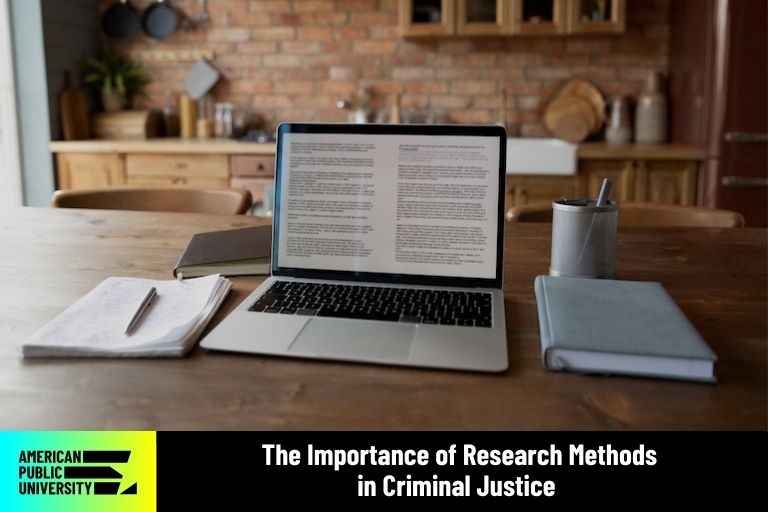By Dr. Jarrod Sadulski | 01/31/2024

Research methods in criminal justice enable researchers to address some of the most pressing issues that affect our society. The criminal justice system is always evolving. It shifts to meet the ever-changing trends in crime and technology.
Criminal justice research provides policymakers and criminal justice leaders with up-to-date and relevant insight to answer many of the challenges that they face. For example, criminal justice research can lead to new policies and even case laws that guide law enforcement officers daily. Policy analysis is used to solve problems in crime and criminology.
I once attended a large conference by the International Association of Chiefs of Police where police leaders from around the world examined criminal justice and criminology. Research formed the backbone of many of the presentations I attended.
These presentations addressed the most pressing problems in modern-day policing and enabled leaders to make informed decisions. Research can influence policy through practical application in criminology and criminal justice.
The Research Process
To obtain information that can shape policies and laws, effective criminal justice research methods are essential. The research process typically involves quantitative, qualitative, or mixed methods research that go through a peer review process to validate the researcher’s findings.
Once that validation occurs, the research is viewed as credible and is ready to be presented to policymakers. Research methods are commonly guided through a theoretical framework in criminal justice. For example, a criminal justice researcher studying police stress may wish to apply Agnew's General Strain Theory to guide the research.
A researcher who may wish to study if someone's upbringing and environment contribute to whether they engage in criminality as an adult may apply a Social Learning theoretical framework. If someone is studying crime mapping, they may wish to apply a Routine Activity theoretical framework.
Research Designs
Effective research begins with a quality research design to address a research problem. The design typically involves:
- A sample that represents a population
- Research questions in qualitative research or hypotheses in quantitative research
- A problem statement
- A purpose statement
A research design of high quality is also important in criminal justice research, and the research design should be detailed. For instance, it should explain how a researcher will collect data from the sample, how the data will be analyzed, and how the researcher’s conclusions should answer the research questions or hypotheses.
Access to participants is vital. That access typically begins with obtaining permission to recruit from an organization, then sending recruitment material to willing participants such as students who are interested in criminal justice and criminology.
Qualitative Methods
In qualitative research interviews, field research, questionnaires, participant observation, case studies, focus groups, and non-experimental methods are common. In data analysis, thematic analysis is commonly used, which involves developing themes obtained through participant data.
Saturation is an important part of this type of work that involves developing themes that occur through each participant's responses. Data between participants and existing literature are triangulated to ensure that there are the same findings among the data collected.
In multiple case studies research, triangulation is used among each case study to draw conclusions. Interviews are common in multiple case studies research.
In qualitative data surveys, open-ended questions are commonly used to collect data. One limitation of this type of research is that rigor in research may be more difficult to demonstrate due to the lack of experimental analysis.
Quantitative Research
Quantitative research tends to be more experimental and involve a scientific method. Data collection through quantitative research may be descriptive and may be collected through self-report surveys. Survey research is a common way to collect data in quantitative research.
Quantitative data analysis often involves experimental tests that recognize relationships between variables. For example, survey research may involve sending surveys to participants who can answer with either yes/no answers or with numerical values that can be analyzed. This analysis may occur through t-tests, an analysis of variance (ANOVA), and other statistical analyses.
Secondary Data Analysis
Secondary data analysis involves using existing research in past research. For example, data may be collected from a published national crime victimization survey or other past survey research.
Secondary research can be helpful in answering a new problem. Social science research involves conducting research to develop information from a study into various social or societal issues.
Various methods can be used in criminological research. Properly designed research methods are an important part of criminal justice research and are explained in the study.
To ensure reliability and validity, another researcher should be able to follow the same data collection to address a research question and should come to the same conclusions. Critical thinking is an important part of content analysis.
Evaluation research can be used by decision-makers in criminal justice because it evaluates the merit and effectiveness of a program or policy. Evaluation research can help decision-makers to understand the effectiveness of policies.
The Role of Students
Students have an important role in serving as researchers. They can aid in policy analysis by addressing a current problem and developing findings that can be published. While completing coursework, students can learn the skills of a researcher and the process of the Institutional Review Board.
Students are also critical consumers of research. They will view a research topic with great interest and can provide useful feedback to academics when needed.

Dr. Jarrod Sadulski is an associate professor in the School of Security and Global Studies and has over two decades in the field of criminal justice. He holds a bachelor’s degree Criminal Justice from Thomas Edison State College, a master’s degree in criminal justice from American Military University, and a Ph.D. in criminal justice from Northcentral University.
His expertise includes training on countering human trafficking, maritime security, mitigating organized crime, and narcotics trafficking trends in Latin America. Jarrod has also testified to both the U.S. Congress and U.S. Senate on human trafficking and child exploitation. He has been recognized by the U.S. Senate as an expert in human trafficking.
Jarrod frequently conducts in-country research and consultant work in Central and South America on human trafficking and current trends in narcotics trafficking. Also, he has a background in business development.

